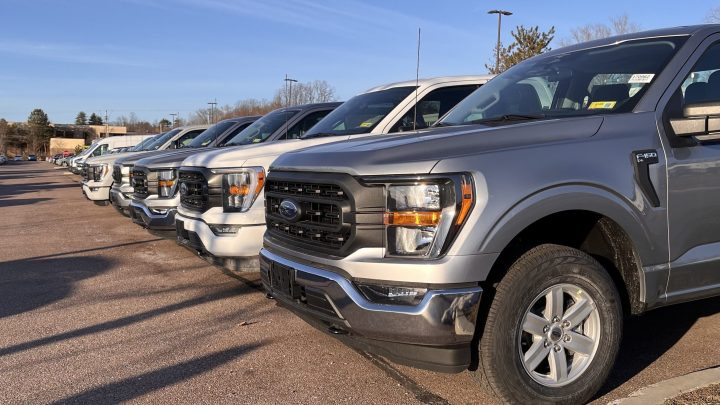
Car dealers’ inventories are up, so haggling and incentives are back
Car dealers’ inventories are up, so haggling and incentives are back

If you want a microcosm of the last few years of inflation, look no further than the prices of new cars and trucks. Average prices started rising fast in the spring of 2021. For two years, they kept rising until finally leveling off last year. They haven’t fallen much since then — but they’re not going up either.
Part of what caused the rapid price hikes was the shortage of new cars. Carmakers couldn’t turn out enough vehicles to keep dealers’ lots full.
But last month, according to Cox Automotive, new vehicle inventories hit their highest level since 2020, and the process of buying and selling new cars is reverting back to some of its pre-pandemic ways too.
You can see that pretty clearly on Shelburne Road, south of Burlington, Vermont. It’s one of those strips filled with car dealerships: Toyota, Ford, Chevrolet, Acura, Audi and Nissan, to name a few. Their lots are pretty full now, which is a significant change from a few years ago.
“We had a lot of customer parking, let’s put it that way,” said Zach Roberts, a sales manager at Heritage Ford, one of those Shelburne Road dealerships.
At the lowest point of the last few years, he said, there were fewer than 10 new cars on his lot. Now? “We’re looking at a great selection of F-150s, Super Dutys, SUVs.”

About 129 vehicles fill the dealership’s lot. To Roberts, those rows of large trucks and SUVs are a relief. Now, he can give customers time to make decisions, which wasn’t really possible before.
“You’d be working the same car deal with three different people at the same time,” he said. “You had to kind of let people know, ‘Hey, I know you want to think about it overnight, but potentially this might sell before tomorrow.’”
A few factors led to that cutthroat market. First, there was the onset of COVID in the spring of 2020.
“Every factory in the world that produces vehicles for the U.S. market shut down,” said Jonathan Smoke, chief economist at Cox Automotive.
Then, there were supply chain snarls. Most notably, a shortage of semiconductors slowed down vehicle production. And because carmakers had a limited supply of chips to work with, “only the most profitable vehicles and the most expensive vehicles within individual models and segments were being produced,” Smoke said.
Meanwhile, demand for vehicles didn’t let up. That led to those nearly-empty dealership lots and, according to Smoke, an unprecedented situation in the auto market. Consumers were “paying more for vehicles than what was on their stickers.”
Before the pandemic, you could usually negotiate a lower price for a new car. But not in the last few years.
In 2023, the chip shortage eased and dealers’ lots started filling up again. So, haggling is coming back.
“This hasn’t quite put it into a scenario where consumers now hold all the power, but they certainly have more advantage than they did six months ago or certainly much more than they did two years ago,” said Stephanie Brinley, associate director at S&P Global Mobility.
Fuller dealership lots have also brought back incentives from carmakers and dealers — things like rebates, discounts and low interest rate offers. These also used to be common in the car market, but they dwindled along with new car inventories. According to Cox Automotive, the average value of discounts and incentives on new cars in January was nearly double what it was a year before.
But while new car inventories look more like pre-2020, they’re not all the way back. That’s because carmakers and dealerships have learned something.
“If they’re at a lower inventory, they can be more profitable,” Brinley said.
Case in point: At Heritage Ford, sales manager Zach Roberts said inventory now is less than half its pre-pandemic normal, and that cuts costs. For one thing, because they have fewer vehicles on the lot exposed to rain and snow, they don’t need to do as much maintenance.
“The last thing we want is having vehicles on the lot that have been here for some time,” Roberts said. “Because then you wonder about brakes. You wonder about, just, conditions.”
Heritage also no longer rents an off-site parking lot to store extra inventory. And since dealerships take out loans for the cars on their lots, having fewer of them means paying less interest. Roberts thinks the dealership has reached the sweet spot.
“I’m hopeful that the inventory will stay around this,” he said. “I don’t think we need more inventory. I think we have plenty of options here now.”
With one exception: The Ford Maverick. It’s a pickup truck on the smaller side that comes in hybrid or gas-powered options and has a starting price well under $30,000. Roberts can’t keep it in stock.
“We’ve had people show up in sweatpants, put their cereal down in the morning, and get here without their checkbook and say, ‘I’m the first one in the door, my wife’s behind me with the checkbook.’ So it’s amazing to see how popular that vehicle is,” he said.
That’s another sign of change in the market: Carmakers are finally starting to build some more affordable models again, and buyers are eager for them.
There’s a lot happening in the world. Through it all, Marketplace is here for you.
You rely on Marketplace to break down the world’s events and tell you how it affects you in a fact-based, approachable way. We rely on your financial support to keep making that possible.
Your donation today powers the independent journalism that you rely on. For just $5/month, you can help sustain Marketplace so we can keep reporting on the things that matter to you.











